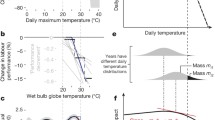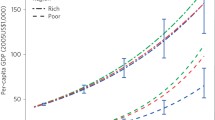Abstract
This paper examines the marginal effects of temperature on the growth rate and variability in growth rate of total factor productivity (TFP) of a country, as measured by its production efficiency relative to a stochastic frontier. Using panel data for 168 countries for the period 1950–2014 to estimate a one-step stochastic frontier function, we find that temperature has a concave relationship with the growth rate of production efficiency and with the variability in this growth rate. We observe that hotter than the average temperature is not only detrimental to production efficiency growth but also makes the growth less stable than otherwise, and these effects are larger in very hot countries with average annual temperature greater than 25 °C. More importantly, we observe that the detrimental marginal effects of higher temperature depend on the level of economic development of a country; they are larger for poor countries relative to rich countries. Our findings have implications for the specification of climate damage functions in integrated assessment models and estimates of country-specific social cost of carbon.





Similar content being viewed by others
Notes
By a non-linear effect, we mean that temperature can have both positive and negative effects on efficiency growth and its variability, within a sample depending on the values of temperature.
Burke et al. (2015) find that productivity peaks at 13 °C and declines at higher temperatures. Therefore, the fall-off in productivity concerning hotter and colder limits implies an optimal temperature zone for economic activities.
Our application captures climate-driven changes in the “fatness” of efficiency growth distribution tails; the importance of which was stressed in Weitzman (2011).
Formulas of estimating the marginal effects are given in the Appendix.
For details on data for climatic factors, please see Burke et al. (2015).
For details on the climatic variable dataset provided by the UEA, please refer to Harrris et al. (2014)
Relevance of population-weighted temperature data over area-weighted temperature data for measuring economic impacts is sector-specific. For example, if the objective is to measure the impacts on labor productivity, then, population-weighted temperature data may be well suited, but if we are measuring the impacts for agriculture, then, this might not be the case. We are thankful to one of the reviewers for pointing out this concern.
Choice of countries has been restricted by availability of data. For the countries included in the study, see Appendix Table A.
Burke et al. (2015) have considered a country to be poor if its purchasing power parity (PPP) adjusted per capita income was below the global median in 1980. An alternative way is to include yearly per capita income as many countries have progressed and have better capacity to adapt to climatic changes since then. But allowing the classification to vary over time could make it an endogenous variable since the unobservable variables that affect current per capita income could also affect TFP.
We assume that the one-sided error term has a truncated normal distribution.
Detailed country level panel results of production efficiency are available from the authors.
Since ∂E(∆μ)/∂T = − ∂E(∆ln y)/∂T, the magnitude of marginal effect of 0.1 percentage points translates into a decrease in output growth by 0.1 percentage points.
Note that we observe a small cluster of points about the optimal zone above the fitted regression line (Fig. 2, panel A1 and panel B1).These points belong to Bhutan, which is a poor country. It reflects that it is not only the location of a country but also level of development that determines climatic effects on production efficiency growth and its variability.
References
Aigner DJ, Lovell CAK, Schmidt P (1977) Formulation and estimation of stochastic frontier production function models. J Econ 6(1):21–37
Athey, S, Bayati, M, Imbens, G, Qu, Z, 2019. Ensemble methods for causal effects in panel data settings. AEA Papers and Proceedings, 109: 65-70
Barreca AI (2012) Climate change, humidity, and mortality in the United States. J Environ Econ Manag 63(1):19–34
Bera AK, Sharma SC (1999) Estimating production uncertainty in stochastic frontier production function models. J Prod Anal 12(2):187–210
Burke M, Hsiang SM, Miguel E (2015) Global non-linear effect of temperature on economic production. Nature 527:235–239
Carleton TA, Hsiang SM (2016) Social and economic impacts of climate. Science 353:6304
Chen Y-Y, Schmidt P, Wang H-J (2014) Consistent estimation of the fixed effects stochastic frontier model. J Econ 181:65–76
Dell, Melissa, Jones, Benjamin F, Olken, Benjamin A, 2012. Temperature shocks and economic growth: evidence from the last half century. Am Econ J Macroecon, 4(3):66–95
Dell M, Jones BF, Olken BA (2014) What do we learn from the weather? The new climate-economy literature. J Econ Lit 52:740–798
Deschênes, Olivier, Greenstone, Michael, 2007. The economic impacts of climate change: evidence from agricultural output and random fluctuations in weather. Am Econ Rev, 97(1):354–385
Dietz S, Stern N (2015) Endogenous growth, convexity of damage and climate risk: how Nordhaus’ framework supports deep cuts in carbon emissions. Economic Journal 125(583):574–620
Forrest K, Tarroja B, Chiang F, AghaKouchak A, Samuelsen S (2018) Assessing climate change impacts on California hydropower generation and ancillary services provision. Clim Chang 151(3–4):395–412
Graff-Zivin J, Neidell M (2014) Temperature and the allocation of time: implications for climate change. J Labor Econ 32:1–26
Greene WH (2005) Reconsidering heterogeneity in panel data estimators of the stochastic frontier model. J Econ 126:269–303
Harrris I, Jones PD, Osborn TJ, Lister DH (2014) Updated high-resolution grids of monthly climatic observations–the CRU TS3.10 dataset. Int J Climatol 34:623–642
Heal, Geoffrey, Park, Jisung, 2013. Feeling the heat: temperature, physiology & the wealth of nations, NBER Working Paper 19725, National Bureau of Economic Research, Inc
Hsiang SM, Burke M, Miguel E (2013) Quantifying the influence of climate on human conflict. Science 341:1235367–1231-14
Im KS, Pesaran MH, Shin Y (2003) Testing for unit roots in heterogeneous panels. J Econ 115(1):53–74
Letta M, Tol RSJ (2018) Weather, climate and total factor productivity. Environ Resour Econ. https://doi.org/10.1007/s10640-018-0262-8
Maddala G, Wu S (1999) A comparative study of unit root tests with panel data and a simple new test. Oxf Bull Econ Stat 61:631–652
Meeusen W, van den Broeck J (1977) Efficiency estimation from Cobb-Douglas production functions with composed error. Int Econ Rev 18(2):435–444
Mendelsohn R, Nordhaus WD, Shaw D (1994) The impact of global warming on agriculture: a Ricardian analysis. Am Econ Rev 84:753–771
Moore FC, Diaz DB (2015) Temperature impacts on economic growth warrant stringent mitigation policy. Nat Clim Chang 5:127–131
Moyer E, Woolley MM, Matteson NJ, Glotter MM, Weisbach D (2014) Drivers of uncertainty in the social cost of carbon. J Leg Stud 43:401–425
O’Donnell C (2016) Using information about technologies, markets and firm behaviour to decompose a proper productivity index. J Econ 190:328–340
Ortiz-Bobea A, Knippenberg E, Chambers RG (2018) Growing climatic sensitivity of U.S. agricultural linked to technological change and regional specialization. Sci Adv 4(12):1–9
Pretis F, Schwarz M, Tang K, Haustein K, Allen MR., 2018. Uncertain impacts on economic growth when stabilizing global temperatures at 1.5°C or 2°C warming. Phil Trans R Soc A 376(2119): 1–19
Schlenker W, Roberts MJ (2009) Nonlinear temperature effects indicate severe damages to us crop yields under climate change. Proceedings of National Academic Sciences 106(37):15594–15598
Shee A, Stefanou S (2015) Endogeneity corrected stochastic production frontier and technical efficiency. Am J Agric Econ 97:939–952
Syverson C (2011) What determines productivity? J Econ Lit 49(2):326–365
Tisgaris P, Wood J (2016) A simple climate-Solow model for introducing the economics of climate change to undergraduate students. International Review of Economics Education 23:65–81
Tol R (2017) Population and trends in the global mean temperature. Atmósfera 30:121–135
Urban DW, Roberts MJ, Schlenker W, Lobell DB (2012) Projected temperature changes indicate significant increase in inter-annual variability of US maize yields. Clim Chang 112(2):525–533
Van Biesebroeck J (2008) The sensitivity of productivity estimates: revisiting three important debates. J Bus Econ Stat 26(3):311–328
Wang H-J (2002) Heteroscedasticity and non-monotonic efficiency effects of a stochastic frontier model. J Prod Anal 18(3):241–253
Wang H-J (2003) A stochastic frontier analysis of financing constraints on investment: the case of financial liberalization in Taiwan. J Bus Econ Stat 21:406–419
Wang H-J, Schmidt P (2002) One-step and two-step estimation of the effects of exogenous variables on technical efficiency levels. J Prod Anal 18:129–144
Weitzman ML (2011) Fat-tailed uncertainty in the economics of catastrophic climate change. Review of Environmental Economics and Policy 5(2):275–292
Wenz A, Leverman A (2016) Enhanced economic connectivity to foster heat stress– related losses. Sci Adv 2:e1501026
Willner N, Otto C, Leverman A (2018) Global economic response to river floods. Nat Clim Chang 8:594–598
Yunfeng Y, Laike Y (2010) China’s foreign trade and climate change: a case study of CO2 emissions. Energy Policy 38(1):350–356
Zhang P, Deschenes O, Meng K, Zhang J (2018) Temperature effects on productivity and factor reallocation: evidence from a half million Chinese manufacturing plants. J Environ Econ Manag 88:1–17
Acknowledgements
We would like to thank Saumya Verma for helping us in drawing the figures. Madhu Khanna gratefully acknowledges support from NIFA, USDA for this research.
Author information
Authors and Affiliations
Corresponding author
Additional information
Publisher’s note
Springer Nature remains neutral with regard to jurisdictional claims in published maps and institutional affiliations.
Electronic supplementary material
ESM 1
(DOCX 10901 kb)
Rights and permissions
About this article
Cite this article
Kumar, S., Khanna, M. Temperature and production efficiency growth: empirical evidence. Climatic Change 156, 209–229 (2019). https://doi.org/10.1007/s10584-019-02515-5
Received:
Accepted:
Published:
Issue Date:
DOI: https://doi.org/10.1007/s10584-019-02515-5




